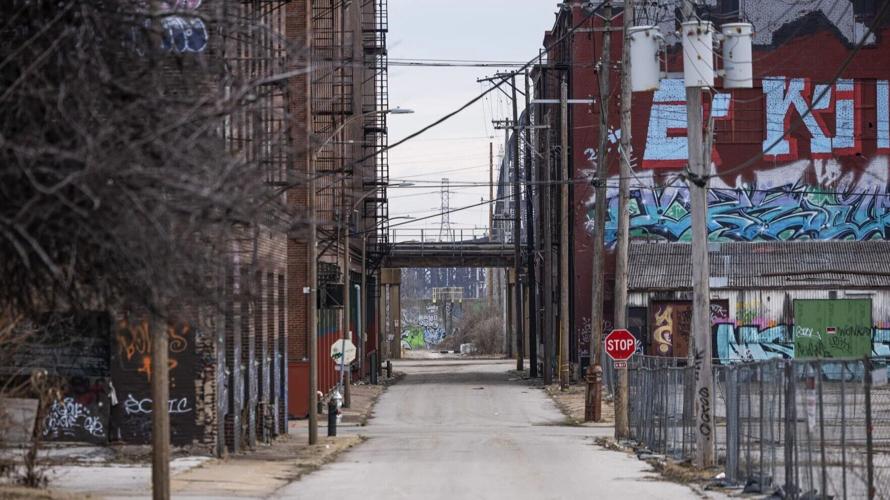
Fences line a dilapidated section of Gratiot Street in the ChouteauβÄôs Landing area of Κϋάξ ”ΤΒ just south of the Gateway Arch on Wednesday, Feb. 26, 2025.¬†¬†
ST. LOUIS¬†βÄî A growing number of civic and business groups are highlighting the metropolitan areaβÄôs stagnant population as an urgent problem, and theyβÄôre pushing the regionβÄôs planning organization to do something about it.
Backers of the effort say they have so far secured a dozen resolutions from professional associations and civic organizations asking the East-West Gateway Council of Governments to coordinate a plan that both puts population growth at the center of the regional agenda and recommends steps to reverse its stall.
ItβÄôs the latest in a long history of efforts here to reverse demographic headwinds that have beset many of the nationβÄôs former industrial powerhouses. The¬†Κϋάξ ”ΤΒ metropolitan area, anchored by what once was one of the nationβÄôs largest cities, has grown far slower than many metro areas, and a falling birth rate threatens to tip it into population decline in the near future.¬†
People are also reading…
βÄ€We are in trouble,βÄù¬†said Chip Casteel, a veteran public policy executive who is working on the latest effort. βÄ€We donβÄôt recognize we are in trouble. But we are in trouble.βÄù
Many of the previous attempts to reverse the slide focused on Κϋάξ ”ΤΒ city. Now that a declining birth rate threatens to saddle even suburban jurisdictions and businesses¬†with some of the issues the city has grappled with for decades, theyβÄôre sounding the alarm.
A lot of the interest in the issue is coming from St. Charles County businesses and governments, Casteel said.
βÄ€Their growth has now slowed to a trickle, and they see it coming and they want to do something about it,βÄù he said.
He is working with Joe Blanner, a lawyer and co-founder of industry group Construction Forum, to build support for a push to get East-West Gateway to add a regional plan for population growth to its portfolio of initiatives, similar to how it facilitated the .
βÄ€In the history of Κϋάξ ”ΤΒ, weβÄôve never had a situation where regionwide, we were able to come together on the type of scale that weβÄôre talking about here,βÄù Blanner said. βÄ€If we can actually accomplish this, it will be very meaningful.βÄù
Fewer immigrants
In the past, Κϋάξ ”ΤΒ could count on its birth rate to exceed population losses due to deaths and outmigration. Since the pandemic, that is no longer the case.¬†Regional population is poised to dip into decline as deaths continue to outpace births in the region, plunging it into what experts call βÄ€demographic winter.βÄù¬†
Last year, the region notched a better-than-normal gain in population of 6,400 people to remain just over 2.8 million residents, according to U.S. Census estimates. That happened because of strong international migration numbers that offset losses caused by 2,200 more people dying than being born and by people moving away from Κϋάξ ”ΤΒ. But immigrants are unlikely to stanch future population losses here,¬†experts say, pointing to Trump administration policies that are choking off refugee programs and other immigration channels.¬†

New U.S. citizens Sravani Street, center left, and Liane Constantine, center right, pose for photos with their families while holding their certificates of citizenship on Thursday, April 3, 2025, after a naturalization ceremony at the Κϋάξ ”ΤΒ Art Museum.
Absent efforts to reverse the trends, there could be significant economic impact in 20 to 25 years,¬†said Ness SΟΓndoval, a Κϋάξ ”ΤΒ University sociology professor who studies the regionβÄôs demographics.
βÄ€This is the first time in Κϋάξ ”ΤΒβÄô history that itβÄôs in a state of natural population decline,βÄù SΟΓndoval said. βÄ€Project forward, youβÄôre looking at a significant decline in high school graduates going out into the workforce for our region. So if you donβÄôt have people moving in, then itβÄôs going to be a shock for a lot of employers, who are going to be like, where are the workers? The workers were never born.βÄù
He called the effort to get East-West Gateway to adopt the issue and study it βÄ€importantβÄù and said the planning group was among the best positioned to build a regional consensus. Reversing the trend will be difficult,¬†SΟΓndoval said, βÄ€so you have to start these conversations now.βÄù
Building support
Groups endorsing the move to get East-West Gateway behind a regional effort include Κϋάξ ”ΤΒβÄô Hispanic Chamber of Commerce and Asian American Chamber of Commerce, and construction associations like the Engineers Club of Κϋάξ ”ΤΒ and the SITE Improvement Association.
βÄ€ItβÄôs a forward-thinking approach,βÄù said¬†Kevin McMullin, director of industry relations at SITE. βÄ€Population is critical to growth and our economic vitality.βÄù¬†
The resolutions endorsed by the groups ask East-West Gateway to βÄ€reach a consensusβÄù on the problem, facilitate agreement on βÄ€a common effort to directly address this challengeβÄù and commit to an βÄ€evidence-basedβÄù process and examination of other fast-growing regions.¬†
The board of the Municipal League of Metro Κϋάξ ”ΤΒ passed a resolution in January, one of the first groups asking East-West Gateway to take up the issue.
βÄ€Obviously East-West Gateway does a lot, and theyβÄôre being pulled in a lot of different directions, but hopefully theyβÄôll recognize the importance of this and try to take this initiative up sooner rather than later,βÄù said Municipal League Director Pat Kelly. βÄ€We would eagerly work on any kind of program they would come up with.βÄù
East-West Gateway Executive Director Jim Wild said his board is set to discuss the population issue during a board and staff retreat this week. In addition to the violence initiative East-West Gateway took on starting in 2023, it has also convened talks on homelessness. Since then, it has received several requests to bring together regional leaders on other issues, including airport coordination, workforce and economic development strategies, quality jobs initiatives, and food insecurity.
During a February board meeting of East-West Gateway, Wild mentioned the request to study population decline and propose regional strategies to combat it. There was some pushback from St. Clair County Board Chairman Mark Kern, who is also vice chair of the planning group that largely is known for coordinating transportation funding dollars.
βÄ€What we do best is transportation,βÄù Kern said. βÄ€ThatβÄôs what works best at East-West Gateway.βÄù
Wild noted then that the groupβÄôs bylaws, however, do state its top job is to work on regional issues. In an interview, he said it may make sense to βÄ€work on connecting the dots a little betterβÄù by connecting the region's various efforts to attract residents, boost quality of life and create jobs, all activities meant to increase population. But Wild said such a conversation needs to be done in a βÄ€positiveβÄù way that doesnβÄôt discourage people from coming to Κϋάξ ”ΤΒ. There could be βÄ€unintended consequences,βÄù he said.
βÄ€I think thatβÄôs something that we need to look at and examine, but itβÄôs really a symptom of bigger issues,βÄù Wild said.
More than a jobs plan
Among the loudest voices for recognizing the need to get Κϋάξ ”ΤΒ growing again has been Greater Κϋάξ ”ΤΒ Inc., the regional business group representing large companies. Asked about the effort to get the issue in front of East-West Gateway, interim CEO Dustin Allison, in a statement, said βÄ€increasing our population and driving inclusive economic growth requires engagement from all quarters.βÄù
βÄ€We will continue our work to grow the regionβÄôs population, and we support action-based efforts that help achieve that mission,βÄù Allison said.
Casteel said a regional population growth plan is broader than an economic development plan such as , and it could include strategies to attract people here from other regions in addition to the economic growth strategies in the 2030 Jobs plan. Casteel argued highlighting the population decline issue is important to communicate its urgency and get every leader thinking about how their organization or government can promote in-migration.
He and Blanner are careful not to advocate any specific strategies, insisting a process to study the issue and come up with solutions will generate buy-in and momentum. The regionβÄôs inability and βÄ€lack of desireβÄù to cooperate has been holding Κϋάξ ”ΤΒ back, Casteel said, but heβÄôs hopeful reversing population loss is one thing everyone can agree on.
βÄ€My assessment is the mere doing of this process will be part of the answer to the problem,βÄù Casteel said.
2024 COUNTY POPULATION ESTIMATES
2024 population estimates for counties in the Κϋάξ ”ΤΒ metropolitan area show the city again saw losses while St. Charles County and neighboring Lincoln and Warren counties all recorded growth. Source: U.S. Census
| COUNTY | 2023 | 2024 | Change |
|---|---|---|---|
| Bond County, Ill. | 16,637 | 16,576 | -0.37% |
| Calhoun County, Ill. | 4,293 | 4,224 | -1.61% |
| Clinton County, Ill. | 36,886 | 37,087 | 0.54% |
| Franklin County, Mo. | 106,444 | 107,256 | 0.76% |
| Jefferson County, Mo. | 231,155 | 231,888 | 0.32% |
| Jersey County, Ill. | 21,158 | 21,150 | -0.04% |
| Lincoln County, Mo. | 64,707 | 65,888 | 1.83% |
| Macoupin County, Ill. | 44,127 | 43,895 | -0.53% |
| Madison County, Ill. | 263,442 | 263,017 | -0.16% |
| Monroe County, Ill. | 35,144 | 34,969 | -0.50% |
| St. Charles County, Mo. | 417,958 | 423,726 | 1.38% |
| St. Clair County, Ill. | 252,094 | 251,149 | -0.37% |
| Κϋάξ ”ΤΒ City, Mo. | 282,772 | 279,695 | -1.09% |
| Κϋάξ ”ΤΒ County, Mo. | 990,875 | 992,929 | 0.21% |
| Warren County, Mo. | 37,815 | 38,478 | 1.75% |
| Κϋάξ ”ΤΒ MSA | 2,805,507 | 2,811,927 | 0.23% |


















